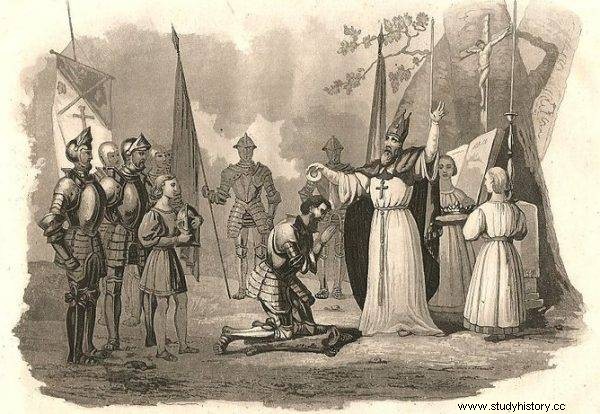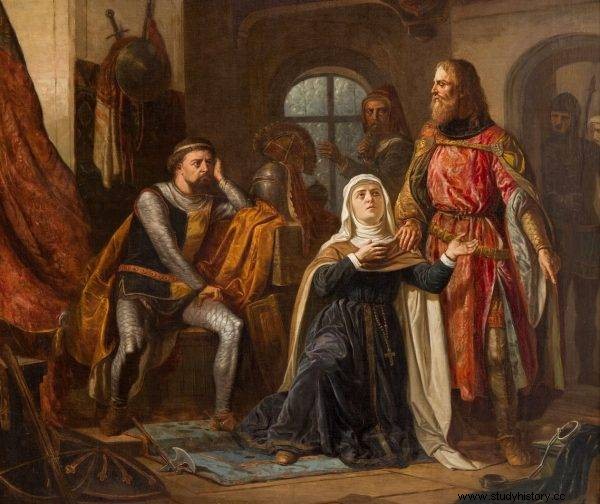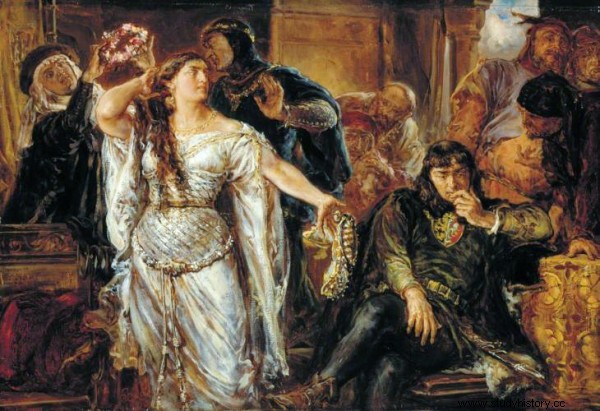They suddenly appeared, emerged from the forests, burned and murdered, stole and enslaved entire families that they were driving north to plant them along the Nemunas. It was not Ruthenia, nor the German element, nor even the Tatars, and the Lithuanians aroused a real terror in medieval Poland. Savage, pagan warriors from the Northeast, speaking an unknown language, invaded the Piast state more than 50 times.
From the beginning of the medieval Piast kingdom, the young country struggled with the invasions of pagan tribes from the north-east - the Prussians, Yotvingians, and Lithuanians. "Educational" missions have already been undertaken - without effect - by Bolesław the Brave. Two centuries later, Konrad Mazowiecki decided to pacify the rebellious Prussians, bringing the Order of the Hospital of the Blessed Virgin Mary to his district, which was just looking for a new seat, after they were expelled from Hungary, when they tried to appropriate the lands granted to them by King Andrzej II.

In the bloody Lithuanian invasions on Poland, he participated, among others Prince Witold and Jagiełło, who later became the throne of our country.
Konrad Mazowiecki did not learn a lesson from the Hungarian passage, but his short-sighted policy at the initial stage worked well. Indeed, the Teutonic Knights "took upon themselves" the pagan Prussians and with exceptional consistency began to move into the interior of the country, exterminating and exploiting the conquered population, replacing the old tribal organizations by erecting first wooden forts, and ultimately powerful castles. This was how an efficient and well-managed monastic state was born.
Mendog superpower
The pacification of the Prussian tribes did not, however, calm the situation in the north-eastern outskirts of the Piast principalities. For at the beginning of the thirteenth century, more and no less brave and savage warriors began to come to the country from the north. This time they were invaders from neighboring pagan Lithuania, which had just entered the path of rapid development, which meant conquests in the east and west.
The creator of its power was kuningas (prince) Mindaugas - that is, Mindaugas. He managed to unite the fragmented Lithuanian principalities, threatened by the expansion of the Teutonic Order from the Prussians and the Knights of the Sword from Livonia, thus creating a strong state . Soon both Ruthenia and the Piast principalities were to find out about it. The Lithuanians, under Mindaugas, quickly conquered large areas of Russia, weakened by the Tartar invasions, thus gaining an additional base for attacks on Poland.

Mindaugas was the creator of the power of Lithuania. He was technically a Christian, but his country remained pagan.
Soon it became clear that it would be the most dangerous enemy from the east for the Piasts. While Russia was then relatively weak after the great devastation of the Tatar invasions, and the Tatars themselves - although extremely cruel and destructive - appeared rarely, Lithuanian attacks were a constant threat.
During the reign of Mindaugas, pagan warriors invaded Poland 14 times. Divisive and quarreling district princes were often completely helpless in the face of the Lithuanian hecatomb. Formally, the Christian Mindaugas (in fact, apart from his baptism itself, his state remained pagan) had no mercy for his enemies. Ruthenia treated it as an area of expansion, while the Piast principalities were for Lithuanians mainly a source of exploitation - riches and slaves.
Prince without a head
There is no doubt that the rival district princes only made the task of the barbarian hordes easier. On the Piast side, something like the awareness of the community of interests and family loyalty, resulting from a cultural or even Christian community, did not matter much when it was necessary to conclude an alliance against, for example, a hated brother. Today it is assumed that at least some of the Lithuanian invasions were inspired by the conflicting district princes.
According to some researchers, this could have been the cause of one of the largest Polish defeats in the battles with Lithuanians, which ended in the devastation of Mazovia and the murder of the local prince Siemowit I.
Siemowit - son of Konrad Mazowiecki - pursued an active policy towards pagan tribes neighboring Mazovia. He invaded the Yotvingians as many as three times in alliance with the Ruthenians. He also entered into an anti-Lithuanian alliance with the Teutonic Knights. In return for support in the voyages to the pagans, he obtained from the order the right to 1/6 of the Yotvingian lands owned by the monks.
The alliance was also supposed to protect Siemowit from the revenge of his brother, Kazimierz, with whom he was in conflict. And Kazimierz had something to take revenge for. Braciszek, together with the prince of Krakow Bolesław the Shy and the Ruthenian prince Daniel Romanowicz, invaded the Kuyavian land that belonged to him, devastating it (and also plundering the land of Łęczyca).

Some of the Lithuanian invasions could have taken place on the initiative of the quarreling Piast princes.
Some historians believe that the devastating Lithuanian invasion of Mindaugas, for whom the alliance of Siemowit I with the Teutonic Knights was a threat, was inspired, and perhaps with the direct support of Kazimierz, who could thus have played back on his brother.
Probably around 1262, the Lithuanians led by prince Trojnat, Mendog's nephew, invaded Mazovia with Russian reinforcements and captured the Jazdów stronghold (now Ujazdów in Warsaw), where Siemowit was stationed at that time. A well-manned stronghold had a chance to defend itself, but there was a traitor in the ranks of Siemowit's warriors. A certain Goszcz (perhaps Kazimierz's man) opened the gates of Jazdów for Lithuanians. During the bloody fights, the invaders managed to capture Siemowit himself. The sentence was carried out on the spot. The prince was killed by beheading. The city went up in smoke. Siemowit's body was also burned.
Slave industry
Siemowit's wife, Perejesław's Ruthenian princess, took on the task of putting the ruined Mazovia on its feet. The Duke of Greater Poland, Bolesław the Pious, helped her in this. He sent his warriors to the district. Lithuanians and Ruthenians withdrew across the Vistula. Bolesław rebuilt the ruined city in Płock.
Soon after, subsequent invasions of barbarians dressed in the skins of wolves, bears and lynxes began to harass the Piast principalities. The Lithuanians had one extremely important goal:acquiring slaves. The captives were abducted on a large scale by whole families . Then, they filled the settlement voids by the Nemunas. The result was depopulation, especially of the eastern Piast principalities, but the invasions could reach far into the country. The warriors of Trojden, a self-proclaimed man in the plunder of Poland, who took over Lithuania as a result of the civil war, reached as far as Łęczyca or Kalisz.
Backed up against the wall, the Piast dukes sought agreement with Lithuanians, even through marriages. This was done by Prince Bolesław II, who married Trojden's daughter Gaudemunda. The invasions of the hordes from the north-east, as he took his hand, stopped harassing Mazovia, but the Lithuanians started attacking Lesser Poland.
Leszek Czarny to trouble
At the end of the 1880s, the Piasts managed to moderate the temperament of the barbarians. The duke of Lesser Poland, Leszek the Black, had merits in the wars with pagans. In 1282 he dealt severely with the allied Lithuanians and Yotvingians, who invaded the present-day Lublin region in the number of about 14,000.
The pagans burned and plundered, but they had a gifted and determined commander against them. 6000 soldiers of Leszek the Black in the Battle of the Narew River chased the enemy, who split into three divisions. The Lithuanians managed to escape with the loot, while the Yotvingians were surprised. The bloody battle ended with their pogrom, and not only in this clash. The Battle of the Narew River is considered to be the beginning of the end of the Yotvingian tribe as such. They never made any expedition against Poland again, but they were also so fragmented and weakened that they ceased to create a separate tribal entity. Those who escaped death at the hands of the Teutonic Knights or the fate of slaves assimilated with the Lithuanians.

At the end of the 1880s, the Piasts managed to moderate the temperament of the barbarians. The prince of Lesser Poland, Leszek the Black, had merits in the wars with pagans.
A year later, the Balts set off for Poland again. The retaliatory raid, however, was a disaster. Leszek Czarny once again proved his great military talent. The Lithuanians broke through the Łuków forests to the Sandomierz region. It seemed that they would murder and steal without consequences this time as well. However, this did not happen. At the village of Rowiny, the duke successfully lured the pagans into a trap by using a mock retreat. The maneuver was successful. The beaten Lithuanians returned home with nothing. This victory calmed down the situation at the border for a while.
It is true that there was no question of the end of the attacks and robberies, but with the beginning of the 14th century the situation changed. Both Lithuania and Poland faced a new threat.
The third one
After 1308, when the Teutonic Knights drowned Gdańsk in their blood and took over Gdańsk Pomerania, it became clear to Władysław Łokietek that they, and not Lithuania, posed a greater threat to the reviving state. The same was true for the Lithuanian princes. At the end of the thirteenth century, the knights of the Order had all the lands of the Prussian tribes under their rule, up to today's Królewiec and Sambia and Skalowia, where the Teutonic Knights founded the city of Regneta and built a mighty castle. The Prusai faced a terrible fate. Their population was wiped out in bloody conquests. It has decreased by more than half from 200,000 people. Those who survived and fell under the Teutonic tutelage were treated as slaves, and Teutonic strongholds grew up in place of old settlements and forests.
The first signs of a warming relationship between the united Piast state and the Lithuanian princes appeared in the times of Władysław Łokietek - from 1320 the king of the reborn Kingdom of Poland. Łokietek entered into an alliance with Lithuanian prince Giedymin, and Łokietek's son - Kazimierz, married Giedymin's daughter - Aldona.

Before the Lithuanians stood shoulder to shoulder with the Poles to fight the Teutonic Knights at Grunwald (pictured), for decades they harassed the Piast state with bloody raids.
The marriage of the children did not completely end the wars with the northern neighbor. During the reign of Casimir the Great, the interests of both countries crossed in Halych Ruthenia. It is true that the Poles ultimately won the competition for these lands, but the Lithuanian invasions continued to plague the country, leading to economic ruin. Just 9 years before the union in Krewo, Lithuanians led by Kiejstut Giedyminowicz invaded the Kingdom of Poland, kidnapping 23,000 people. people. Paweł Jasienica wrote:"The Lithuanians walking along the right bank of the Vistula reached Tarnów, burning everywhere, plundering, taking loot and prisoners" .
Interestingly - probably Kiejstut's son, Prince Witold, and his nephew ... Jagiełło took part in this expedition. Nine years later, the same Jagiełło arrived not to Tarnów, but to Kraków. The union in Krewo was dictated not only by the Teutonic threat, but also by the desire to resolve the dispute over the Ruthenia of Halychyna, to which both countries claimed. The condition for concluding the alliance was the baptism of Jagiełło and his marriage with the Queen of Poland - Jadwiga Andegaweńska.
Politically, a freshly baked Christian with a until recently hostile, pagan Lithuania contributed to this "union" with a territorially powerful country. In the 14th century, the Grand Duchy of Lithuania was 800,000 square kilometers and was one of the largest countries in Europe. However, ethnically Lithuanian lands constituted only 10 percent of the country. The rest were Ruthenian lands, annexed as a result of conquests. It was the same with demographics. The vast majority of the inhabitants (even 1.7 million against 300,000 Lithuanians) were Slavic Ruthenians. A considerable percentage of those taken prisoners also came from Poland.
The Union in Krewo has completely changed the political system of our part of the continent. The Teutonic Knights were suddenly pushed on the defensive. Their state was surrounded by a great Baltic-Slavic country, and also - at least formally - Christian. The end of the Polish-Lithuanian feud turned out to be a breakthrough on many levels. The Jagiellonian dynasty began to rule in the Kingdom of Poland, the order was slowly losing its influence and importance, while Krewa was the very beginning of the state, which in less than 200 years had grown into a regional power with a specific culture and system. I am talking about noble democracy and the Polish-Lithuanian Commonwealth.
